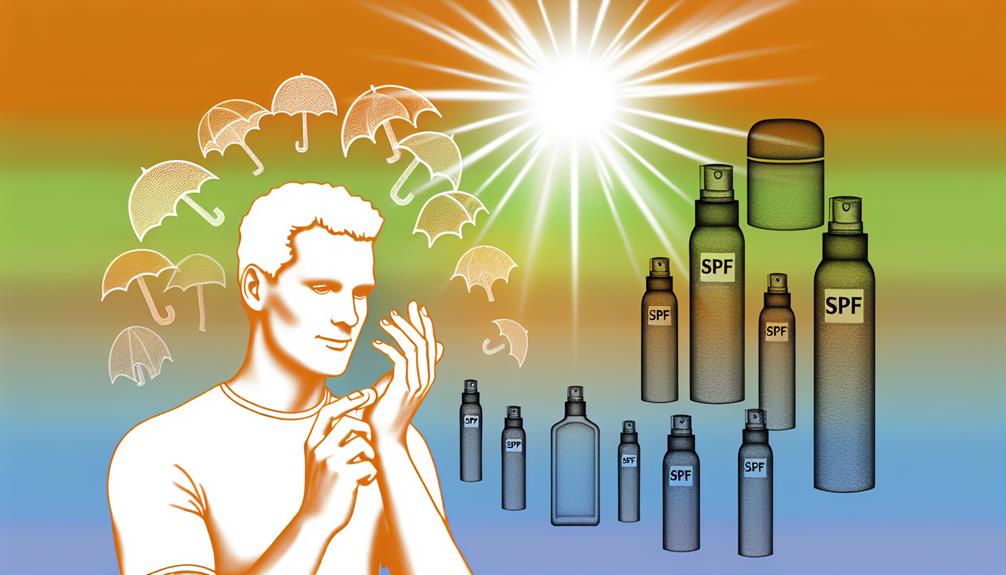


When it comes to sunscreen, it’s not just about slathering it on and hoping for the best. You need a plan to guarantee every inch of exposed skin is protected. Experts suggest specific amounts for different body parts, but how do you measure it out?
And what about reapplication, especially if you’re swimming or sweating? These questions are vital for maximizing your sunscreen’s effectiveness and safeguarding your skin against harmful UV rays. So, how much sunscreen should I use, and how often should I reapply? Let’s break it down step by step.
SPF, or Sun Protection Factor, measures how well a sunscreen will protect your skin from UVB rays. These rays are responsible for sunburn and can contribute to skin cancer. Understanding SPF effectiveness is vital for making informed decisions about sunscreen application.

When you see an SPF number on a sunscreen bottle, it indicates how much longer you can stay in the sun without burning compared to not wearing any sunscreen. For instance, if you usually start to burn after 10 minutes, an SPF 30 sunscreen theoretically allows you to stay in the sun for 300 minutes without burning. However, this is under ideal conditions, and the actual effectiveness can vary.
To maximize SPF effectiveness, apply sunscreen generously and evenly on all exposed skin. Don’t forget areas like the ears, back of the neck, and tops of feet.
It’s recommended to apply sunscreen 15-30 minutes before going outside to allow it to bind properly to your skin. Reapply at least every two hours, or more often if you’re sweating or swimming.
Also Read: Summer Skincare: How To Protect Your Skin In The Sun?
To make sure you’re applying the right amount of sunscreen, consider using the Two-Finger Rule. This method guarantees that you achieve sufficient coverage for your skin, maximizing both protection and the sunscreen’s effectiveness.
Here’s how you can use the Two-Finger Rule:
When applying sunscreen to your face and neck, make certain to use a broad-spectrum formula to protect these sensitive areas from harmful UV rays. Begin by squeezing out about a nickel-sized amount of sunscreen for your face and an additional dime-sized amount for your neck. This guarantees proper coverage without missing any spots.

For the best application technique, start by dotting the sunscreen on different areas of your face—forehead, cheeks, nose, and chin. Then, gently rub it in using circular motions, making certain it’s evenly distributed. Don’t forget the areas around your eyes and ears, as they’re often overlooked but equally vulnerable to sun damage.
Move on to your neck, applying the sunscreen in upward strokes to avoid pulling on the skin. Be thorough and cover both the front and back of your neck. If you have short hair or wear your hair up, make certain to extend the application to the nape of your neck as well.
Also Read: Sunscreen For Your Skin Type: Finding The Perfect Match
Covering your body with sunscreen requires a generous amount to guarantee every exposed area is well-protected from UV rays. It’s essential to apply sunscreen properly to ensure effective sun protection.
Here are some coverage tips for different body parts:
Proper sunscreen application is crucial for maintaining healthy skin. Make sure you evenly spread the sunscreen on all exposed body parts. It’s easy to miss spots like your ears, the tops of your feet, and the back of your neck, so be thorough.
After ensuring thorough coverage, it’s pivotal to remember that sunscreen needs reapplication to maintain its effectiveness. Even the best sunscreen won’t protect you all day without reapplication. So, how often should you reapply? Generally, you should reapply sunscreen every two hours, especially during direct sun exposure. This frequency helps counteract the breakdown of the sunscreen’s active ingredients by UV rays.
If you’re swimming, sweating, or toweling off, reapply more frequently—typically every 40 to 80 minutes, depending on the product’s water resistance.
Using the proper technique is essential. Apply a generous amount evenly over all exposed skin. Don’t forget areas like the ears, back of the neck, and tops of the feet.
Choosing the right sunscreen depends on the activities you’ll be engaging in, whether it’s lounging on the beach, hiking, or playing sports. Different activities expose your skin to varying levels of UV radiation and environmental factors, so it’s essential to tailor your sunscreen choice accordingly.
When choosing a sunscreen, it’s crucial to consider factors such as skin type, allergies, and any particular skin conditions you may have. For individuals with sensitive skin, search for sunscreens labeled as hypoallergenic and free of fragrances and dyes. These formulations are less likely to cause irritation. Mineral-based sunscreens with zinc oxide or titanium dioxide are typically a reliable choice for sensitive skin, as they rest on top of the skin instead of being absorbed.

Water resistance is another important aspect, particularly if you intend to swim or sweat. Opt for a sunscreen labeled ‘water-resistant‘ if you’ll be active outdoors. These sunscreens are formulated to remain effective for up to 40 or 80 minutes in water, but remember, you still need to reapply them as directed on the container.
If you have a specific skin condition like eczema or rosacea, seek advice from your dermatologist for suggestions. They may recommend a specialized sunscreen that addresses your individual needs. Don’t ignore any allergies you may have; always review the ingredient list to prevent negative reactions.
Also Read: Mineral Sunscreen: Safer Sun Protection Explained
Applying the right amount of sunscreen is crucial for effective UV protection. Remember, a nickel-sized amount for your face, a dime-sized for your neck, and 1 teaspoon each for your arms and legs.
Don’t forget 2 teaspoons for your torso and 0.5 teaspoon for your hands and feet. Cover every exposed area, including often-missed spots like your ears and the back of your neck.
Follow these guidelines to keep your skin safe and healthy.